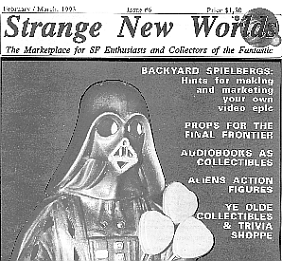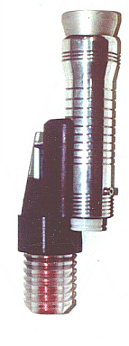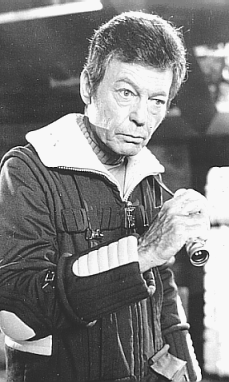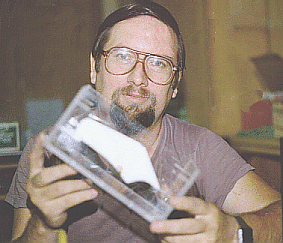
Reprinted with permission of the Author.
Was printed in Strange Worlds a toy Collecting Magazine 4 - February 1993
Interview was given via phone, some mistakes are in the text but left
as written.
PROFILE:

Richard Coyle
Props For The
Final Frontier
by Archie Waugh
MOST "STAR TREK" FANS only dream of being part of science fiction's
most beloved and successful series. For master propmaker Richard Coyle, 44, of Phoenix,
Arizona, that dream has been a reality for over ten years. This former television
repairman has helped transfer Roddenberry's television legend to the big screen in four of
the "Star Trek" feature films.
Coyle's personal space odyssey began m 1977 with the premiere of Star Wars. His
obsession with this film that redefined big-screen science fiction led him that year to
his first convention, the WorldCon in Phoenix.. There he was thrilled to meet and shake
hands with his long-time idol Robert Heinlein. Properly hooked, he soon became an active
conventioneer. Attired in space-swashbuckler costumes, he often participated in the rowdy
gaming that was common at conventions in those days before peace-bonding. Utilizing his
background in electronics, he built his own rayguns by taking off-the-shelf toy guns and
customizing them with lights and sound effects. The weapons caused such a sensation that
he was soon busy filling orders. His work caught the eye of a buyer for a prop company and
Coyle soon found himself in Hollywood.
One of his first assigranents was for Star Trek II.- The Wrath of Khan. His job
was to modify existing Trek props and to detail new ones. Star Trek II abandoned the bland
functionality of Star Trek.TheMotionPicture in favor of more colorful, comic- book-style
visuals reminiscent of the TV series. According to Coyle, director Nick Meyer would
inspect the set while chomping a ever-present cigar and demanding "more winkie
blinkies!"
 Coyle
was soon busy wiring every hand prop insight. Sharp eyed viewers can spot examples
of his handiwork throughout the film. Coyle constructed Captain Terrell's wrist-communicator
from an off-the-shelf jogging computer. He added lights and a Plexiglass face,
then hid the power supply up the actor's sleeve. "The Enterprise fire extinguishers
were commercial ones," said Coyle. "We dressed them out with acrylic
and copper tubing from a refrigerator supply house." Coyle created the
bosun's whistle used during Spock's funeral from a G.I. Joe toy accessory.
Coyle
was soon busy wiring every hand prop insight. Sharp eyed viewers can spot examples
of his handiwork throughout the film. Coyle constructed Captain Terrell's wrist-communicator
from an off-the-shelf jogging computer. He added lights and a Plexiglass face,
then hid the power supply up the actor's sleeve. "The Enterprise fire extinguishers
were commercial ones," said Coyle. "We dressed them out with acrylic
and copper tubing from a refrigerator supply house." Coyle created the
bosun's whistle used during Spock's funeral from a G.I. Joe toy accessory.
The scene where McCoy examines Chekov with a medical scanner provided Coyle
with a laugh. 'McCoy is holding [the scanner] upside down," said Coyle. "I guess
I must have designed it wrong, 'cause he's the doctor!"
When working on predesigned items, Coyle still managed to leave a personal imprint. While
detailing the new communicators, Coyle added a button labeled "translock. " This
is a literal reference to a long-stated ability of the ship's @porter to "lock on' to
a communicator's signal to locate the persons preparing to beam up.
Coyle enjoyed creating the props, although he was dismayed to see many of his
creations end up on the cutting room floor. Unable to convince his employers to let him
build science fiction props "on spec," he went independent. Starting as a
subcontractor on Icepirates, he built an impressive resume over the ensuing years.
Projects included The Last Starfighter (he made Robert Preston's communicator from an old
Star Trek II medical scanner), Airplane, Radioactive Dreams, "The Powers of Matthew
Star," and "The Greatest American Hero."
Eventually "Star Trek' called him again. Coyle cites Star TrekIV- 7he
Voyage Home as his favorite experience on the film series. As an independent contractor,
Coyle had relatively free run of the Paramount lot. He was the last person photographed in
the dilithium chamber where Spock died. After he posed for the photo, the chamber was
converted into the Klingon computer room.
Viewers of this film are often unaware that many hand props that Kirk and his
Federation renegades use are Klingon devices. The characters supposedly scrounged these
Klingon acceswries from the Bird of Prey they captured in the previous film. In Star Trek
IV, notice the phaser that Kirk uses to weld the hospital door. It is a Coyle- designed
Klingon hand phaser.
Richard Coyle also created Scotty's lighted clipboard. A beautifully
illuminated plexaglass welding device that he created, alas, is visible only briefly in
the background of one scene. For the welding visors used by the Vulcan workers seen early
in the film Coyle modified the Navy's gold, high-altitude helmet visors.
One of Coyle's favorite props for Star Trek IV also became the most
frustrating. The script required that the particle collector that Chekov and Uhura take to
the aircraft carrier be a blend of Klingon and Federation technology. Coyle constructed a
com plicated and sturdy device that used an antique, folding flash-camera reflector as an
antenna/collector. "Unfortunately, Nimoy rejected the device as too cluttered."
Coyle spent the next two days at Paramount bashing details from the prop with a hammer, a
testament to its solid construction.
On Star Trek V. 7he Final Frontier, Coyle worked under modelmaker Gregory Gein.
Mr. Gein had design responsibilities for the film's models and props. Consequently, Coyle
worked on both props and minitures in this film. Coyle did detailing on the miniature of
the Voyager probe seen destroyed by the Klingons early in the film.Many new props were
created for Star Trek V. communicators, tricorders, assault rifles, Captain Kirk's
"malfunctioning" logbook pad, and the medical device that Dr. McCoy used on his
father.
 Coyle
laughs when recalling the electronic binoculars that McCoy uses in the film's
Yosemite scene. "Greg Gein brought in these binoculars he had worked up...
he had left no room in them for the electronics. I duplicated his design in
styrene and packed it full. When Deforest Kelley looks in them, he's got a 9-volt
battery stuck in each eye."
Coyle
laughs when recalling the electronic binoculars that McCoy uses in the film's
Yosemite scene. "Greg Gein brought in these binoculars he had worked up...
he had left no room in them for the electronics. I duplicated his design in
styrene and packed it full. When Deforest Kelley looks in them, he's got a 9-volt
battery stuck in each eye."
For the recent Star Trek VI.- The Undiscovered Country, Coyle built new assault
phasers, anew bosun's whistle from Greg Gien's design, the lighted translators used by Kir
k and McCoy in the trial scene, and the Klingon leg irons. The latter were built to
Paramount specifications that, according to Coyle, "made no sense. They were way too
large. When we sent them down to the set, they were quickly deemed unusable, except for
when the shape shifter turns into a little girl and slips out of them. As they had ordered
quite a few of these, I got stuck with a lifetime supply of over-sized Klingon leg
irons."
Coyle has mixed feelings about his Hollywood experiences. "There are
always frustrations when the prop you worked so hard on ends up virtually invisible on
screen.' Coyle so far has not contributed to "Star Trek: The Next Generation" or
"Deep Space Nine." Paramount's in-house design team, headed by Michael Okuda and
Rick Sternback, produces all the props for the series. No matter what the future brings,
chances are good that Richard Coyle will continue making the future tangible for
present-day audiences. Trekkers can often find tricorders and phasers made by Coyle for
sale at conventions. All his hand-crafted replicas bear his signature and the same quality
craftsmanship that he brought to the feature films.









